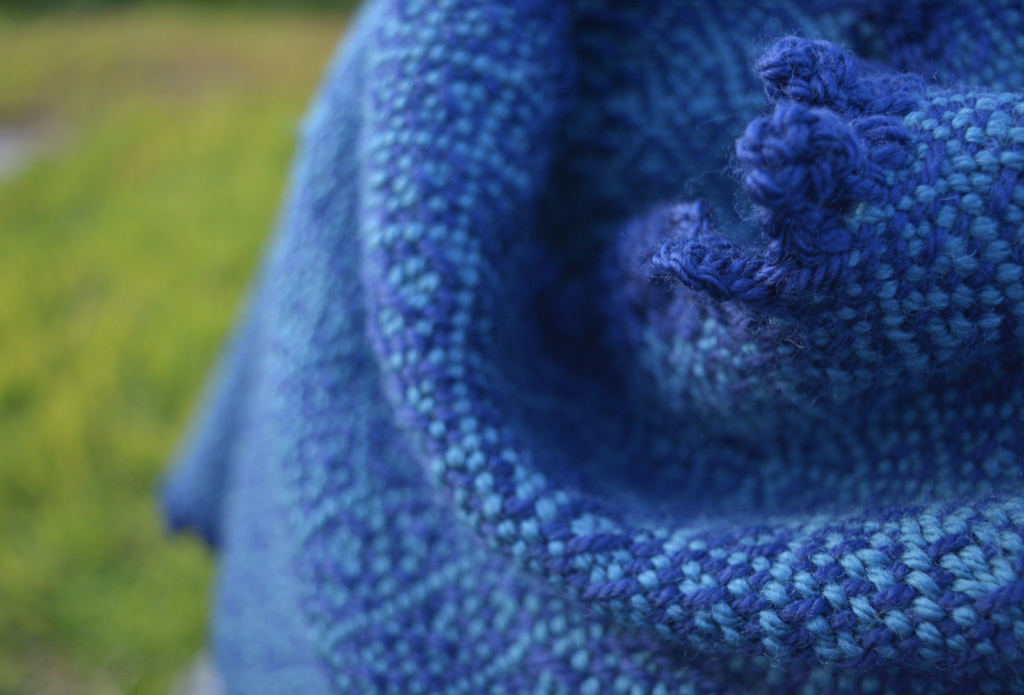Perhaps a better question might be “What can’t I do on a rigid heddle loom?”. Yes, it’s that versatile!
I already mentioned in the previous post that you can create more complex patterns by using multiple heddles/reeds. For example, if I want to weave a 4 shaft pattern, I can use 3 heddles/reeds to achieve that, as demonstrated in my Three Heddle Adventures class. Or, if I want to use 2 heddles I can also weave some really awesome patterns, as demonstrated in my Weaving with Two Heddles class. However, many rigid heddle weavers also achieve more complex patterns by using pick up sticks to manipulate threads that are threaded in the slots of the heddle/reed. You could think of these threads as “uncommitted”, (not threaded in a hole) so free to play around with. One of the more impressive examples of complex patterns with pick up sticks is Jeen’s Pinwheels, which is actually an 8 shaft pattern! You can see another great example of that on FarmNana. I also have a simplified 4 shaft pinwheels class if that interests you!
I already mentioned in the previous post that you can create more complex patterns by using multiple heddles/reeds. For example, if I want to weave a 4 shaft pattern, I can use 3 heddles/reeds to achieve that, as demonstrated in my Three Heddle Adventures class. Or, if I want to use 2 heddles I can also weave some really awesome patterns, as demonstrated in my Weaving with Two Heddles class. However, many rigid heddle weavers also achieve more complex patterns by using pick up sticks to manipulate threads that are threaded in the slots of the heddle/reed. You could think of these threads as “uncommitted”, (not threaded in a hole) so free to play around with. One of the more impressive examples of complex patterns with pick up sticks is Jeen’s Pinwheels, which is actually an 8 shaft pattern! You can see another great example of that on FarmNana. I also have a simplified 4 shaft pinwheels class if that interests you!
My Midnight Shawl pattern uses 2 heddles/reeds to achieve a diamond pattern.
Another great boon to rigid heddle weavers is the use of Colour and Weave techniques. To break it down to a simple form, you arrange your warp and weft colours in such a way that, even though you’re usually working plain weave, it can look like an impressive and complicated pattern.
My Log Cabin Table Runner is a good example of the use of Colour and Weave.
My newest Youtube video shows you what you can do by thinking outside the box. I show you how to make a wavy and a zigzag shuttle from cardboard, so fun!
Did you know that you can use your rigid heddle loom for tapestry too? You can read more about that in this post. I also share my tapestry thoughts in this video.
There are many possibilities with tapestry on the rigid heddle loom! This video series outlines the use of freestyle tapestry.
Krokbragd is one of my favourite weave structures, and is easily achievable on a rigid heddle loom. I have written about it, and have many videos on Youtube, as well as a few online classes. I just love it!
I could really go on and on because there is so much more you can do with this humble loom. Hopefully what I’ve written here has convinced you of the capabilities of rigid heddle weaving and given you some more material to look into.
Until next time…
Happy Weaving!
